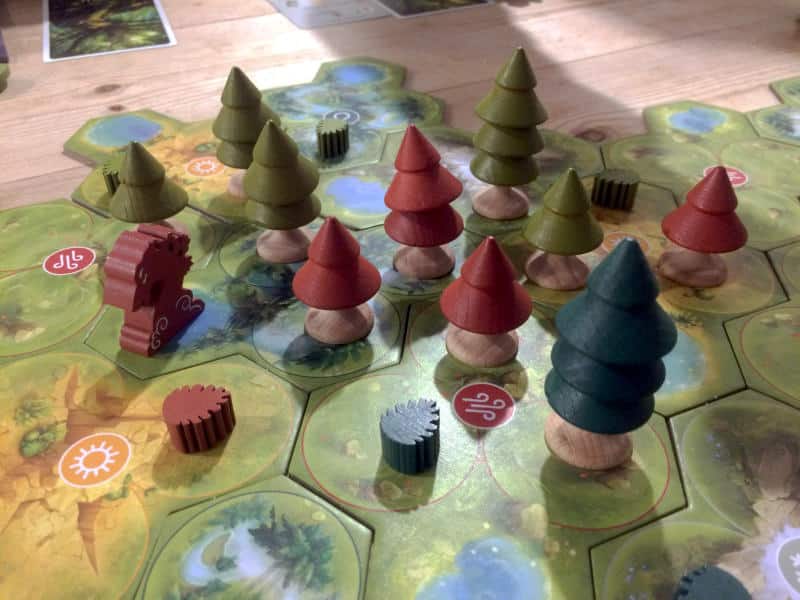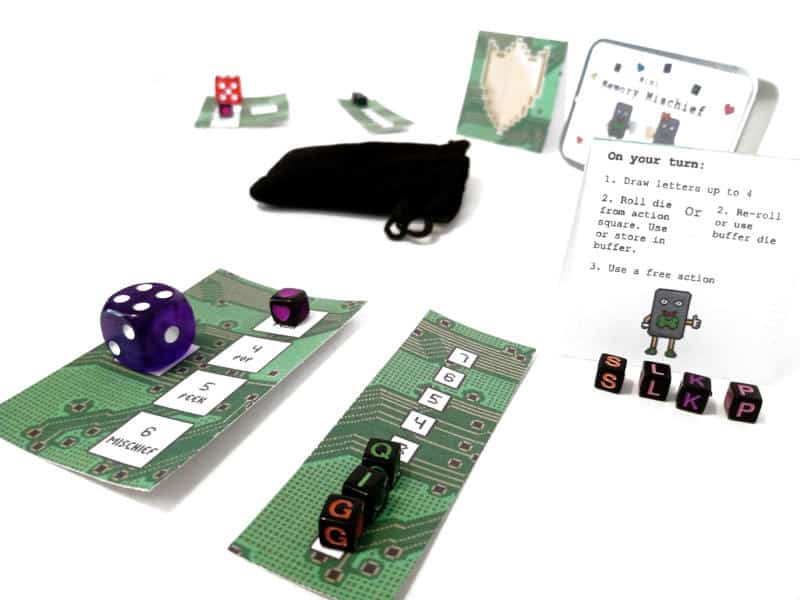After talking to Gaiagames at Berlin Brettspiel Con this year, I was impressed by how much they focus on sustainability for their games, not just when it comes to the product itself, but also the gameplay experience. It spurned me on to write about the topic of our hobby’s impact on the environment and how that manifests itself in so many different, faceted ways.
Of course, it’s not the first time that I published an article on the matter. Previously, my focus was much more on the use of plastics. My article “Plastic fantastic” talked about how plastic can sometimes be the perfect material to achieve specific goals, while at other times it could easily be replaced with more environmentally friendly solutions. I followed this up about a year later with my article “Less is more“, where I talked about how publishers are working on replacing plastic with more sustainable materials. Another year after that, my article “Carbon-neutral games” listed a number of games that actively tried to be as carbon-neutral as possible. So, if you go by these articles, you can get a sense of a positive trend. It’s time for me to take stock again and see what the latest developments are in the quest to make our industry more sustainable.
Naturally Sustainable
I think the main trend I have seen in our hobby recently is towards natural materials. I mean, wood-pulp products are what most people will associate with board games: paper, cardboard and even wood itself. Of course, just using these natural materials isn’t going to make things more sustainable. First of all, using wood products from FSC-approved sources is the first step.
The Forest Stewardship Council‘s certification means that wood products are verifiably sourced sustainably at every step of the chain, “from forest to consumer” as their website puts it. The FSC label stands for “zero deforestation, safeguarding of ancient and endangered forests, fair wage and work environment, biodiversity preservation and community rights, including the rights of Indigenous Peoples.” There a different types of FSC labels, but ultimately, if a game has one of those printed on the box, then that’s a great sign and something to look out for.
Gaiagames takes the idea of naturally sustainable components to another level though. Instead of wooden cubes or cardboard tokens, their game Ecogon uses dried beans as counters. That’s a clever solution, because dried beans are very sustainably produced, stored and shipped in large quantities. Of course, Ecogon isn’t produced in a food-safe environment, but in theory, you could cook and eat the beans that come in the box – even though I don’t recommend you do.
Plastic Alternatives
Efforts are also being put into reducing or completely removing the need for plastic. We have to remember that a game without plastic components often stills gets shipped in bubble wrap or foam beans to protect the box from dings and dents. Even inside the box you often still find decks of cards wrapped in shrink wrap. In fact, many publishers still wrap each game in plastic to protect it during transit and storage from moisture.
The good news is that much of the plastic is slowly being replaced by alternatives. The most common solution I have seen is paper bellybands around decks of cards instead of plastic shrink wrap. I have also noticed that bubble wrap and foam beans are rarely used any longer. Instead, crunched-up paper or shredded cardboard protect game boxes from rough handling in transit.

My favourite way of keeping games safe during shipping was for Forests of Pangaia from Pangaia Games. The game came inside another cardboard box, with very thick, double-layer sides, which contained the game box and was inside the shipping box. So it was cardboard inside cardboard inside cardboard and it did the job amazingly well.
Tackling the shrink wrap around the game box is the trickiest part though and closely linked to where games are manufactured versus where they are needed. Shipping games across the ocean and storing them in containers in a port for a long time creates the problem of moisture and the game warping or going mouldy. The answer that Gaiagames and some other publishers have come up with is simply to produce their games closer to where they are needed. You can store games in climate-controlled warehouses for a long time, so removing long-distance shipping removes the need for plastic shrink wrap.
Carbon Emissions
Speaking of shipping leads us nicely to carbon emissions. If you manufacture your games close to where your customers are, then your carbon footprint is likely to be smaller. Of course, it’s not quite as simple. Theoretically, a big company in China that uses 100% renewable energy could be the better choice when compared to a local company that’s very carbon-heavy. On the whole, though, I would argue that having the games made near to where they need to go is likely to be less carbon-intensive.
Speaking of renewable energy during manufacturing, that is another good thing, which some publishers have adopted. Others have opted for carbon offsetting, for example by planting a certain number of trees, instead of reducing carbon emissions. I don’t know how sustainable this actually is, but it’s better than not bothering at all. There are some publishers who have gone a step further. Pangaia Games for example have planted one tree for every game unit ordered.
Let me return to the problem of shipping. Companies like Postmark Games are side-stepping the issue by making print-and-play games. So you download a PDF and print it yourself. There is no physical shipping. Mind you, using the internet as a storage and delivery medium isn’t sustainable per se, but it’s still a move in the right direction in my view.
Atikin Games‘ approach to reducing carbon emissions is to assemble and package their games by hand. There are no machines involved after the components have been manufactured.

Other Approaches to Sustainability
There is also a brand new development on the horizon. CGE have announced what they call re-wood. According to the company, “this new technology combines wood waste and recycled binding material in an 80:20 ratio, creating biodegradable products, including intricate board game bits.” It looks like re-wood can be moulded very much like conventional plastic. I’m sure there will be differences, but it sounds very promising indeed. Maybe your next miniature will be made of re-wood instead of plastic.
Finally, a number of publishers and people from the board game industry have come together to publish the Green Games Guide. Its goal is to help make the tabletop game industry more sustainable. The guide talks about materials that make up a game, as well as box size and packaging. It contains concrete advice that the industry can adopt to become “part of the solution”, as the website puts it.
I am sure there are many more things that can be done or are already in place. If you know of any, please post them in the comments below. I would love to hear what else is happening to make our hobby more sustainable.
Useful Links
- Gaiagames: https://gaiagames.
de/ - Berlin Brettspiel Con: https://berlin-con.
de/ - “Plastic fantastic” article: https://tabletopgamesblog.
com/ 2019/ 09/ 03/ plastic-fantastic/ - “Less is more” article: https://tabletopgamesblog.
com/ 2020/ 07/ 07/ less-is-more-topic-discussion/ - “Carbon-neutral games” article: https://tabletopgamesblog.
com/ 2021/ 11/ 02/ carbon-neutral-games-topic-discussion/ - Forest Stewardship Council (FSC): https://fsc.
org/ en - Forests of Pangaia review: https://tabletopgamesblog.
com/ 2023/ 05/ 20/ forests-of-pangaia-saturday-review/ - Pangaia Games: https://www.
pangaia. games/ - Postmark Games: https://www.
postmarkgames. com/ - Atikin Games: https://atikingames.
com/ - Daybreak: https://www.
daybreakgame. org/ - re-wood: https://czechgames.
com/ en/ home/ news-23-07-27-introducing-re-wood/
Audio Version
Intro Music: Bomber (Sting) by Riot (https://www.
Music I Use: https://www.bensound.com/free-music-for-videos
License code: AHLJTQHZUS5VJXHE
Music I Use: https://www.bensound.com/free-music-for-videos
License code: I3FTO6AJASEF1EJI
Playlist
These are the songs I listened to while I was writing this topic discussion article:

